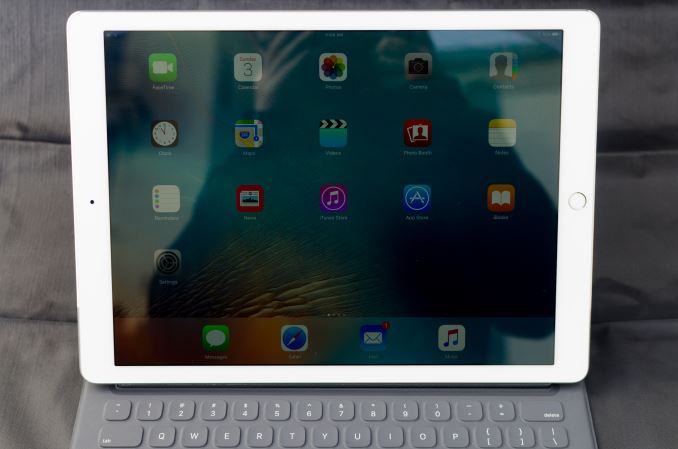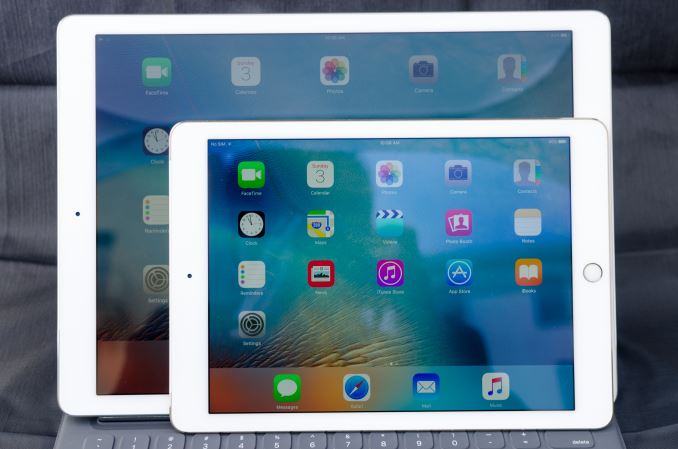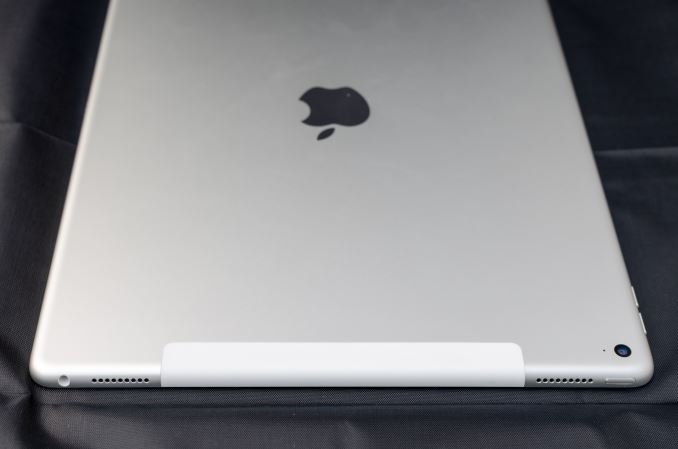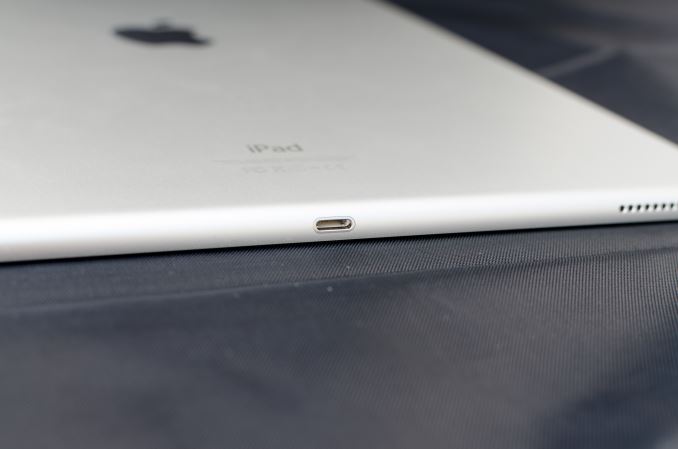The Apple iPad Pro Review
by Ryan Smith, Joshua Ho & Brandon Chester on January 22, 2016 8:10 AM EST
At this point it probably isn’t a secret that tablet sales have leveled off, and in some cases they have declined. Pretty much anywhere you care to look you’ll see evidence that the tablet market just isn’t as strong as it once was. It’s undeniable that touch-only tablets have utility, but it seems that the broader market has been rather lukewarm about tablets. I suspect at least part of the problem here is that the rise of the phablet has supplanted small tablets. Large tablets are nice to have, but almost feel like a luxury good when they’re about as portable as an ultrabook. While a compact laptop can’t easily be used while standing, or any number of other situations where a tablet is going to be better, a compact laptop can do pretty much anything a touch-only tablet can. A laptop is also going to be clearly superior for a significant number of cases, such as typing or precise pointing.
As a result, large touch-only tablets feel like they’ve been limited to home use as a computer away from the computer. Tablets are great when you’re on the couch or in bed, but once you get to this point there are some obvious questions as to whether it makes sense to drop $500+ USD on a tablet that seems to have relatively limited utility. The Surface lineup has been showing signs of growth, but in general the Surface is more of a mix between laptop and tablet rather than a tablet. I would argue that given the OS and overall design that the Surface and Surface Pro are really more laptop than tablet, even if at the hardware level the Surface Pro 4 and Surface 3 are basically tablets with kickstands and keyboard covers.
If you’re guessing that this means Apple has had some issues with growing sales of their iPad lineup, you’d be right. From my first experiences with the iPad 3, I was impressed with the improved user experience for things like web browsing and other smartphone tasks, but I never really felt like it made enough sense to get one for myself. The iPad Air 2 was once again impressive and I felt like I could recommend it to other people that wanted a tablet, but I personally struggled to come up with a reason why I would buy it.
This brings us to the iPad Pro. This is probably the first time Apple has seriously deviated from traditional iPad launches, putting together a tablet built for (limited) productivity and content creation rather than just simple content consumption, creating what's arguably the iPad answer to the Surface Pro. To accomplish this, Apple has increased the display size to something closer to that of a laptop, and we see the addition of a stylus and a keyboard cover for additional precision inputs. Of course, under the hood there have been a lot of changes as well, so the usual spec sheet can be found below to summarize those changes.
| Apple iPad Air 2 | Apple iPad Pro | |
| SoC | Apple A8X 3 x Apple Typhoon @ 1.5GHz |
Apple A9X 2 x Apple Twister @ 2.2GHz |
| GPU | PowerVR 8 Cluster Series6XT (Apple GXA6850) |
PowerVR 12 Cluster Series7XT |
| RAM | 2GB LPDDR3 | 4GB LPDDR4 |
| NAND | 16/64/128GB | 32/128GB |
| Display | 9.7" 2048x1536 IPS LCD | 12.9" 2732x2048 IPS LCD |
| Size and Mass | 240 x 169.5 x 6.1mm 437g WiFi, 444g LTE |
305.7 x 220.6 x 6.9 mm 713g WiFi, 723g LTE |
| Camera | 8MP Rear-Facing, f/2.4, 1.1 micron, 1.2MP Front-Facing, f/2.2 | |
| Battery | 27.3Wh | 38.5Wh |
| Launch OS | iOS 8 | iOS 9 |
| Cellular Connectivity | MDM9x25 Category 4 LTE + GPS/GNSS in Cellular SKU | |
| Other Connectivity | 2x2 802.11a/b/g/n/ac + BT 4.2, Apple Lightning | |
| SIM | Optional NanoSIM | |
| Price | $499/599/699 16/64/128GB | $799/949/1079 32/128GB/128GB LTE |
At a high level, the iPad Pro gains a larger display with a higher resolution, more memory, a new SoC, and a larger battery to compensate for the change in display size. In addition to these changes, the iPad Pro also brings noticeable changes to the speakers, with an increase to four speakers which allow the iPad Pro to compensate for device orientation when projecting stereo audio.
Design
The most immediate change that you can see in the iPad Pro is the sheer size. The 12.9” display of the iPad Pro basically makes it feel like you’re carrying a laptop around. I would argue that this doesn’t actually affect the portability of the iPad Pro, but this is mostly because the iPad Air 2 was something that I only carried in a backpack to begin with. People carrying their tablets in a small bag, purse, or even just in their hands will notice the difference, so the change in size might be more or less noticeable depending upon how you carry things around.
The increase in size does affect weight. After significant use, I honestly don’t think the mass is a significant issue. It does feel heavier than the iPad Air 2, but the mass distribution is such that there isn’t a ton of battery hanging out at the edges of the device where it’ll affect the moment of inertia. This does raise the question of whether Apple included enough battery for sufficient battery life, but that’s a question best left for the rest of the review.
In terms of design, the iPad Pro is rather unremarkable if you’ve ever seen an iPad Air before; it is for all intents and purposes a bigger iPad Air. On the front, the display dominates, with some bezels on the sides and top. The top has the front-facing camera, and the bottom has the home button with TouchID.
Looking at the sides of the tablet, the top edge has the power button and 3.5mm port, along with two of the four speakers. The right edge has the volume buttons, and the bottom edge has the Lightning port and the other two speakers. The left edge is mostly empty, but contains the Smart Connector for the Smart Keyboard and similar accessories.
The back of the tablet is mostly unremarkable as well. For the LTE model, an RF window is visible on the top of the device to allow LTE and other connectivity to function. For the WiFi variants, it looks like the bottom display bezel and the bottom two speakers are the RF windows, so there aren’t any visible areas that indicate where the WiFi antennas are.
Overall, the iPad Pro feels like an iPad, with nothing all that remarkable beyond its size which is carried well. I never really noticed the mass or size of the iPad Pro even if it is clearly larger and heavier than the iPad Air 2. I also didn’t notice any issues with the back cover flexing, but given enough pressure on the back cover pretty much any device this large will see some screen distortion or bending. The iPad Pro does technically regress in thickness compared to the iPad Air 2, but I never noticed the difference in practice, especially when the larger display is really what matters more.
















408 Comments
View All Comments
ddriver - Sunday, January 24, 2016 - link
Bing is a professional application for every professional lamer. To the latter, the ipad "pro" is a professional product too.ddriver - Sunday, January 24, 2016 - link
LOL At most 2 or 3 of those could qualify for "professional" if one is inclined to be generous with the labels.Professional applications - photoshop, 3d max, maya, solidworks, coreldraw, indesign, visual studio, cubase, pro tools, after effects, fusion, z-brush, and so on.
10101010 - Friday, January 22, 2016 - link
Yeah, I'm sure that's why the combined "hammer + screwdriver" tool market is just booming.ddriver - Friday, January 22, 2016 - link
Yeah, I am sure making good analogies is not your strong point.A more appropriate analogy would be those screwdriver kits with a single handle and interchangeable tips, saving you the effort to carry around 20 different screwdrivers, and those kits are GREAT ;)
But we aren't talking just any hardware here, we are talking computers, and general purpose at that, this is not the case of some special purpose hardware. This is a general purpose computer, and what it does is defined entirely by its software. Absent any software, it is just a paper weight, or a serving tray, absent professional software it is just a toy, intended to milk people out of their money.
lmcd - Tuesday, February 9, 2016 - link
I mean, a lot of the times they are bought in bundles ;)abazigal - Friday, January 22, 2016 - link
Possibly because there isn't a hybrid that is as good as a dedicated laptop and a dedicated tablet. You are essentially trading one set of compromises for another, and people's mileage will vary.ddriver - Friday, January 22, 2016 - link
So a "hybrid" being 10% heavier and 10% thicker than a tablet, and 10% slower than a laptop justifies buying and carrying a tablet and a laptop instead of a hybrid?Obviously, a hybrid will be a little slower than a laptop and a little heavier than a tablet, but in many cases that is not detrimental. People should have the option to use their devices to the full extent of their capabilities, and whoever needs the extra horsepower will buy a laptop or even a desktop system instead.
I really don't understand how come people have such a big problem with maximizing a device capability and productivity? IN what way will the availability of professional software for iOS hurt you?
10101010 - Saturday, January 23, 2016 - link
I just don't see a "hybrid" being defined primarily by size, weight, or speed. If we look at a hybrid such as the "Surface Pro", it is defined mostly by its Windows 10 operating system. This is an insecure loaded-with-spyware-at-the-factory desktop OS that pretends to be a tablet OS, laptop OS, server OS, phone OS, etc. There are really no great Windows apps made specifically for a tablet (although a few work nicely with a pen/stylus). So at the end of the day what is a Surface Pro "hybrid" really? It is a desktop OS and a keyboardless laptop. It's marketed as "best of both" but really it is a Frankenstein computer made of parts that Microsoft sawed off other products.Contrast Microsoft's Frankenstein with the iPad Pro -- a tablet built to be a tablet that runs what is widely regarded as the most stable, secure, and highest quality mobile OS. And delivers the closest thing yet to "paper and pencil" functionality to the market. Your point about the professional software is right on. As the apps evolve for the iPad Pro and more professional apps become available, it will only expand what an iPad Pro can be used for, opening the tablet up to being useful for more customers.
ddriver - Saturday, January 23, 2016 - link
I am sure iOS is spying on users as much as Windows 10, after all, M$ was largely inspired by Apple in this regard. And unlike W10, you can't really disable it in iOS.Unfortunately, the lack of professional applications, whose UI is usable on a tablet is true, be those windows, android or ios tablets. I do acknowledge that the only reason windows tablets have the upper hand is they can run the good old legacy professional software, which is a pain in the ass to use without a mouse and keyboard.
It would seem that the industry is rather unimaginative, they keep releasing new versions of their professional products, but don't adopt a better paradigm for user interaction, one that would work equally well on a traditional desktop PC and a tablet. Software giants are just as lazy and unimaginative as hardware giants.
And it is not like it is impossible, it is well within the realm of possibility to adapt the UI for wider device usage without impairing productivity, if anything, a more clever design will make application interaction easier, a lot of the professional app UIs are a pain to work with, even with a mouse, and practically impossible to use with a touch device.
One of the projects I am currently working on is a graphical programming language / IDE, capable of producing commercial grade software, and it is equally useful on a desktop with mouse and keyboard and on a tablet or even on a phone with touch. It is 2-3 months away from public release, unfortunately due to apple's policies, I will not be publishing to their store, since they don't really allow the degree of freedom an application development tool requires. It will still be available for jail broken apple hardware.
Constructor - Saturday, January 23, 2016 - link
I am sure iOS is spying on users as much as Windows 10, after all, M$ was largely inspired by Apple in this regard. And unlike W10, you can't really disable it in iOS.That is just nonsense. Apple is very careful about looking at user data, and in fact they credibly follow the tenet "the less of your information we look at, the better!".
That is not how Microsoft is proceeding with Windows 10 – there they seem to go more the Google route.